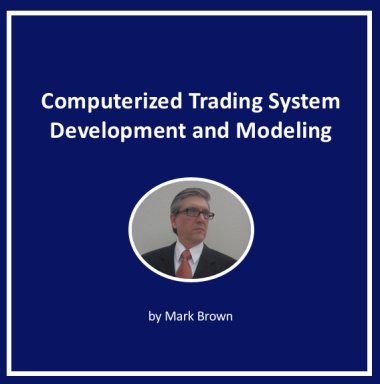
Originally published: 12/07/2018 16:59
Publication number: ELQ-25847-1
View all versions & Certificate
Publication number: ELQ-25847-1
View all versions & Certificate

Creating a Mechanical Trading Model
Shortcut to Discovery. Learn to create a Mechanical Trading Model
Description
Detailed and outlined below are the primary building blocks one can use to construct a successful, fully mechanical trading model. Establishing and utilizing core techniques, ideas and strategies that have been rigorously tested, a firm foundation is established on which many mechanical trading systems can be created and built upon for trading a broad range of markets.
Foundational Components for the System Trader Modeling Mechanics
Understated, would be the use of the word "complex," to describe the process required to develop a robust and fully mechanical trading model or system. Only with the advent of the computer have we been able to analyze and test theories and ideas which would have been previously impossible to calculate in a practical, thorough and timely manner.
Mental Conditioning
Psychological attitude is a key element to any endeavor and trading is not an exception. The researcher’s mind must be open and free from misconceptions. Throughout the development
process, an open mind and the attitude that anything is possible must be preserved as well as
actively pursued. A tenacious commitment and a passion for the process of discovery are also good
traits to acquire and cultivate.
Strategy Process
If we are to have any success trading the markets, we must rely upon a well−planned mechanical strategy. A mechanical system is nothing more than an idea, which has been tested and then, automated. Mechanical research allows a trader to discern a good idea from a bad idea. Being able
to examine facts and not rely upon human emotions will provide the trader a much more solid foundation for a successful trading system. Modeling a system produces a significant benefit in that
capital is preserved through the process of being able to reject many ideas when subjected to
computerized back testing. Mechanical trading will not, by itself, overcome the emotional side and
aspects of trading. However, after a period of testing, time and real−time trading experience, you
will be able to gain confidence if you have a sound method and system.
Capital Commitment
Long−term commitment to mechanically trading the markets requires proper capitalization coupled
with a total commitment to following the system. The capitalization and investment that is required
to endure the inevitable system drawdowns is not to be taken lightly. It is highly recommended that capital allocated to trading the markets or a respective system be only the "risk capital" portion of a person's total available investment portfolio. Typically, it would not be unreasonable to expect a
perfectly sound/robust trading methodology to exceed its tested maximum historical drawdown
percentage by a factor of two (2). This unforeseen and statistically more valid drawdown calculation
will, more often than not, happen sometime in the future. A serious and also very common detriment
to capitalization is the desire to over trade.
1
Detailed and outlined below are the primary building blocks one can use to construct a successful, fully mechanical trading model. Establishing and utilizing core techniques, ideas and strategies that have been rigorously tested, a firm foundation is established on which many mechanical trading systems can be created and built upon for trading a broad range of markets.
Foundational Components for the System Trader Modeling Mechanics
Understated, would be the use of the word "complex," to describe the process required to develop a robust and fully mechanical trading model or system. Only with the advent of the computer have we been able to analyze and test theories and ideas which would have been previously impossible to calculate in a practical, thorough and timely manner.
Mental Conditioning
Psychological attitude is a key element to any endeavor and trading is not an exception. The researcher’s mind must be open and free from misconceptions. Throughout the development
process, an open mind and the attitude that anything is possible must be preserved as well as
actively pursued. A tenacious commitment and a passion for the process of discovery are also good
traits to acquire and cultivate.
Strategy Process
If we are to have any success trading the markets, we must rely upon a well−planned mechanical strategy. A mechanical system is nothing more than an idea, which has been tested and then, automated. Mechanical research allows a trader to discern a good idea from a bad idea. Being able
to examine facts and not rely upon human emotions will provide the trader a much more solid foundation for a successful trading system. Modeling a system produces a significant benefit in that
capital is preserved through the process of being able to reject many ideas when subjected to
computerized back testing. Mechanical trading will not, by itself, overcome the emotional side and
aspects of trading. However, after a period of testing, time and real−time trading experience, you
will be able to gain confidence if you have a sound method and system.
Capital Commitment
Long−term commitment to mechanically trading the markets requires proper capitalization coupled
with a total commitment to following the system. The capitalization and investment that is required
to endure the inevitable system drawdowns is not to be taken lightly. It is highly recommended that capital allocated to trading the markets or a respective system be only the "risk capital" portion of a person's total available investment portfolio. Typically, it would not be unreasonable to expect a
perfectly sound/robust trading methodology to exceed its tested maximum historical drawdown
percentage by a factor of two (2). This unforeseen and statistically more valid drawdown calculation
will, more often than not, happen sometime in the future. A serious and also very common detriment
to capitalization is the desire to over trade.
1
This Best Practice includes
PDF





